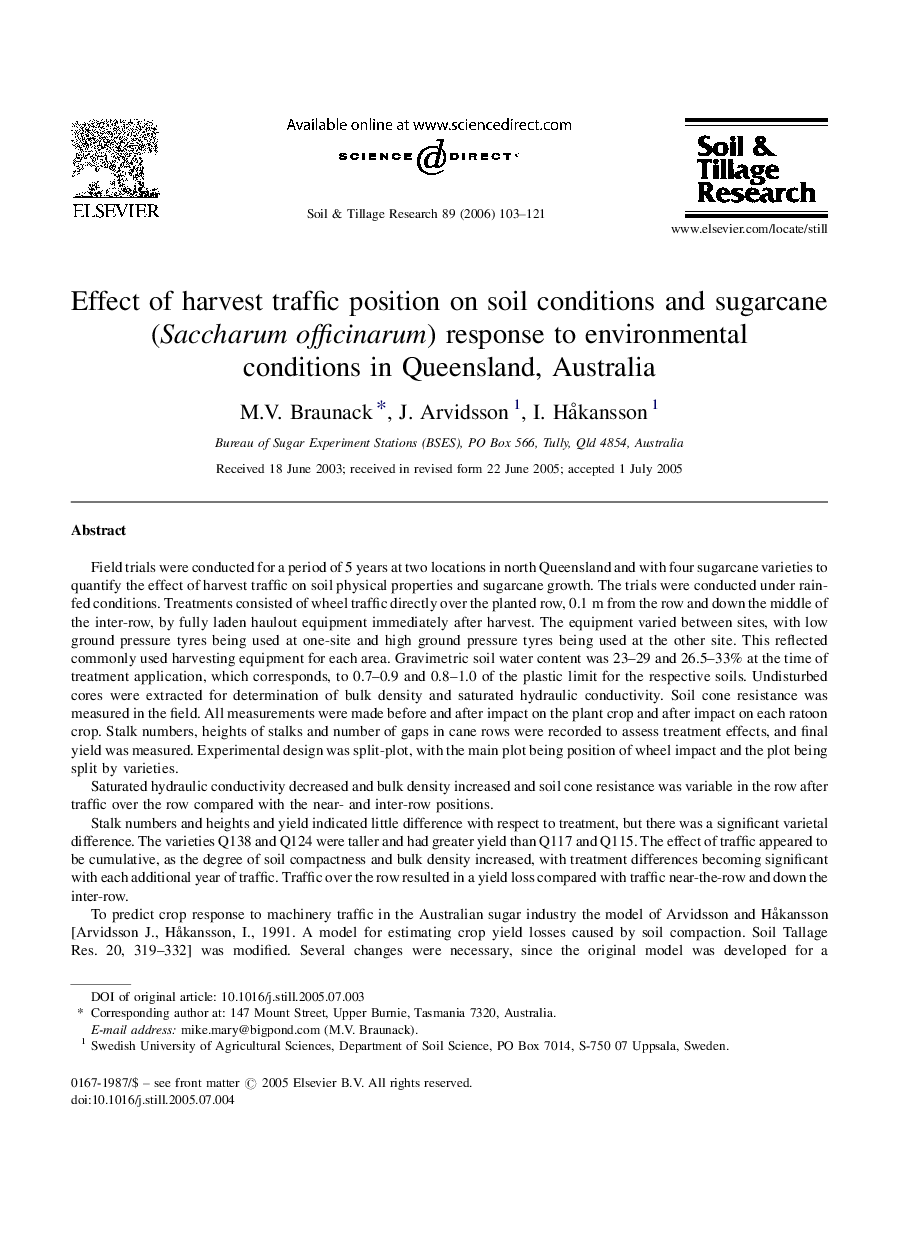| کد مقاله | کد نشریه | سال انتشار | مقاله انگلیسی | نسخه تمام متن |
|---|---|---|---|---|
| 306616 | 513105 | 2006 | 19 صفحه PDF | دانلود رایگان |

Field trials were conducted for a period of 5 years at two locations in north Queensland and with four sugarcane varieties to quantify the effect of harvest traffic on soil physical properties and sugarcane growth. The trials were conducted under rain-fed conditions. Treatments consisted of wheel traffic directly over the planted row, 0.1 m from the row and down the middle of the inter-row, by fully laden haulout equipment immediately after harvest. The equipment varied between sites, with low ground pressure tyres being used at one-site and high ground pressure tyres being used at the other site. This reflected commonly used harvesting equipment for each area. Gravimetric soil water content was 23–29 and 26.5–33% at the time of treatment application, which corresponds, to 0.7–0.9 and 0.8–1.0 of the plastic limit for the respective soils. Undisturbed cores were extracted for determination of bulk density and saturated hydraulic conductivity. Soil cone resistance was measured in the field. All measurements were made before and after impact on the plant crop and after impact on each ratoon crop. Stalk numbers, heights of stalks and number of gaps in cane rows were recorded to assess treatment effects, and final yield was measured. Experimental design was split-plot, with the main plot being position of wheel impact and the plot being split by varieties.Saturated hydraulic conductivity decreased and bulk density increased and soil cone resistance was variable in the row after traffic over the row compared with the near- and inter-row positions.Stalk numbers and heights and yield indicated little difference with respect to treatment, but there was a significant varietal difference. The varieties Q138 and Q124 were taller and had greater yield than Q117 and Q115. The effect of traffic appeared to be cumulative, as the degree of soil compactness and bulk density increased, with treatment differences becoming significant with each additional year of traffic. Traffic over the row resulted in a yield loss compared with traffic near-the-row and down the inter-row.To predict crop response to machinery traffic in the Australian sugar industry the model of Arvidsson and Håkansson [Arvidsson J., Håkansson, I., 1991. A model for estimating crop yield losses caused by soil compaction. Soil Tallage Res. 20, 319–332] was modified. Several changes were necessary, since the original model was developed for a cropping system based on annual cultivation, whereas sugarcane is a perennial crop grown in rows with no annual cultivation. The modified model was validated using data from the trials described in this paper. Agreement between measured yield loss and predicted yield loss was reasonable. This is the first attempt to provide the Australian sugar industry with a tool to assess the yield loss due to harvesting traffic and the economic cost of that loss. The model has the potential to provide, with further development, an indication to growers as to the benefit of restricting traffic to the inter-row area, restricting the number of passes by haulouts, harvesting under drier soil conditions and using high flotation haulout equipment. This should aid in more informed management decisions with respect to harvesting equipment or to the consequences of harvesting under adverse soil conditions.
Journal: Soil and Tillage Research - Volume 89, Issue 1, August 2006, Pages 103–121